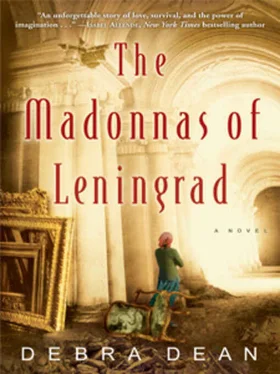It’s a Madonna, but there must have been a hundred Madonnas in these rooms, and when Marina is tired and hungry, they start to blur into one another. She is always tired and hungry now, even just after eating.
Marina stares at the wall, but all she can see are women in enormous hoop skirts and self-satisfied gentlemen in powdered wigs. For some reason, the Early Italian Renaissance Room has become a temporary home for a dozen court portraits en route to the vaults. They have been left leaning against all the walls.
Think, she chides herself. Everything in the museum was displayed in strict order of chronology and provenance. So after the two Gerinis, early-fifteenth-century Florentine school, comes…what?
“Close your eyes,” Anya says. “All you can see with your eyes open is the room as it is now.”
Marina does as she is told.
“Now, go into your memory and pretend that you are leading a tour again. Walk into the room again.”
She imagines walking into the room. She is leading a tour of dukes and duchesses, the figures from the court portraits. The Early Italian Renaissance Room, she informs them. In your day, you would have known it as the First Reception Room. You would have waited here to meet with the ambassador or members of the court. She can see the white stuccoed walls, intersected with paneled pilasters. The paintings are hung in a single row above the blue stone wainscot.
Sure enough, the paintings begin coming into focus in her mind: the crucifixions, the saints, the Madonna in her dark green robes and gilt halo.
“She’s the one with the two saints and the little angels at her ears. Oh, what’s her name?” Marina hesitates and then it comes in a rush. “ Madonna and Child with the Saints James the Less, John the Baptist and Angels . Bicci di Lorenzo. Florentine school. I don’t remember the dates.”
Marina had thought this would be easier. After all, she has led tours of these rooms for two years, and she prided herself on having learned more of the collection than some guides who had worked there a decade. But she has quickly discovered how spotty her knowledge is. On the general museum tours, they skipped entire wings and walked groups through many of the rooms without stopping. Even on the specialized excursions through the picture gallery, they described only a few selected paintings in each room. In this room, for instance, they stopped only at the smallest painting in the room, Martini’s Madonna of the Annunciation .
She has no trouble with the pieces that were on her tour scripts, but it is harder to remember the paintings in between, though she has passed them thousands of times. And then there are the countless vases and bibelots, and all the marble cupids and busts and torsos.
Anya, however, was a room attendant. She would spend an entire day sitting in one spot, and over the years, she seems to have committed the entire museum to memory. She can walk into a room, go to any spot on the wall, and describe for Marina what was there. She has no formal schooling in art and knows nothing about styles or schools or the individual provenances, sometimes not even the name of the artist or the work, but she knows what everything looked like. Her memory is limited only by what she couldn’t see from her chair. For instance, in the Hall of Twenty Columns, where the numismatic collection was displayed, Anya can describe each vase on its pedestal and the placement around the hall of the various glass-fronted cases, but the contents of those cases might have been buttons or candies for all she knows. Otherwise, she is a marvel. Marina doubts that even Director Orbeli himself knows the contents of the museum as well as Anya does. In fact, she has wondered if perhaps she should tell Orbeli about Anya. Mightn’t she be useful when the art comes home again, to speed up the rehanging?
When she brought this up with Uncle Viktor, though, he said, “I am sure Iosef Abgarovitch knows what is in his own museum, Marina, and doesn’t need the help of one of the babushki.”
“But isn’t it amazing?” Marina persisted. She felt as though she had discovered a treasure, like Uncle Viktor must have felt when they found the first cuneiform at Karmir-Blur. “It’s not just the important pieces she knows. We were walking down the 1812 Gallery yesterday and she described the faces of the generals.” There are more than three hundred of these portraits, and to Marina they are indistinguishable, one from the next.
Viktor, though, wasn’t particularly impressed. “It is a parlor trick, Marina. What is the use of this if she doesn’t even know who they are?”
It is a good question, and Marina doesn’t know how to answer it. She thinks that somehow it must matter, though, to see the art even if one doesn’t know what it means.
The Leonardo Room is as hushed as a nursery. Here there are no frames, only the two freestanding panels that held Leonardo’s Madonnas. Marina pauses at the first panel and recites. “ The Madonna and Child , known also as the Benois Madonna, by Leonardo da Vinci. An early work of Leonardo’s, one of two Madonnas begun by him in Florence in 1478. This is one of the few undisputed originals by the master.”
Of all the Madonnas in the museum, Marina could never forget this one. She loved this mother and child and misses the two of them with a particular ache. The Mary is completely human, not a remote beauty but a young girl delighted with the surprise of this child, and the Christ Child is so fat and dimpled, a fleshy baby like Mikhail when he was younger. He perches on little Mary’s lap, his pudgy fingers grasping at the flower she holds up to his gaze and studying it as a scientist might. Secretly, she thinks of this painting as hers. With Mary’s high forehead, they even resemble each other, and Marina has sometimes fantasized that she herself could be the model.
“Such a mess. Do you see this?” Anya is standing in front of the other panel, the one that held the second Leonardo Madonna. She shakes her head and clucks, pointing to the floor at her feet. Sand has drifted or been tracked from the corner, where it is heaped on a tarpaulin. “This will scratch the varnish.”
She points across the room to where a push broom has been left leaning in the doorway. “Get me that, would you, dear?”
Marina walks across the parquet and fetches the broom. When she turns around, the old woman is kneeling in front of the panel like a penitent before an altar, her head bowed, her skirt pooled on the floor.
She sees Marina watching her and says, “I will say a prayer for you, too.”
“I’m not a believer,” Marina objects.
The old woman appraises her. “Everyone believes in something.” Then she smiles and says, “But you mean that you are too educated to believe in the superstitious nonsense of old people. Yes?” She waits for Marina to answer, but the girl is polite and says nothing.
“Then my prayer will do you no harm.”
With a practiced gesture, the old woman touches her fingers to her forehead, her belly, and each of her shoulders and begins mumbling to herself. Marina averts her eyes, with the same embarrassment she feels when she witnesses the spastic fumbling of cripples or the ranting of the feebleminded. She wonders if she should leave Anya alone, but this, too, seems rude, and so she waits, leaning on the broom and studying the blank wall to which Anya is praying.
Out of the shadowy square of paneling that marks where the painting once hung, the Litta Madonna materializes. With her aquiline nose and porcelain features, the Madonna is the perfect study of contentment, gazing down at her nursing child. The Christ Child, though, is the center of the painting. He is not a blank lump of sweet pink flesh but already commands an adult presence. With one hand, he grasps the exposed breast and suckles absently, his dark, shadowy eyes gazing out of the painting, sizing up the scene before him, an elderly Soviet cleaning woman kneeling at his feet. He looks unsurprised.
Читать дальше












